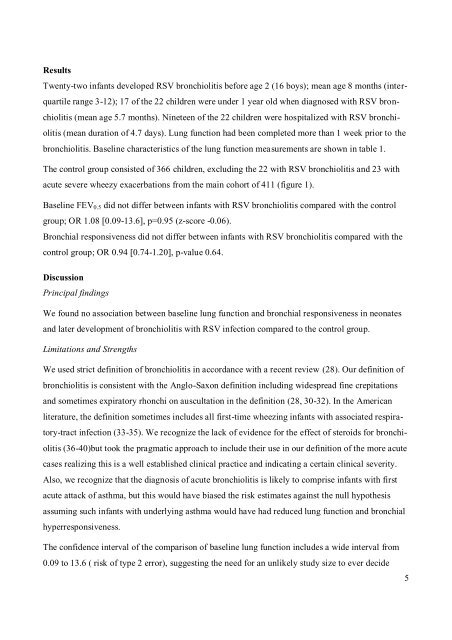Lung function measurements in children - copsac
Lung function measurements in children - copsac
Lung function measurements in children - copsac
You also want an ePaper? Increase the reach of your titles
YUMPU automatically turns print PDFs into web optimized ePapers that Google loves.
Results<br />
Twenty-two <strong>in</strong>fants developed RSV bronchiolitis before age 2 (16 boys); mean age 8 months (<strong>in</strong>terquartile<br />
range 3-12); 17 of the 22 <strong>children</strong> were under 1 year old when diagnosed with RSV bronchiolitis<br />
(mean age 5.7 months). N<strong>in</strong>eteen of the 22 <strong>children</strong> were hospitalized with RSV bronchiolitis<br />
(mean duration of 4.7 days). <strong>Lung</strong> <strong>function</strong> had been completed more than 1 week prior to the<br />
bronchiolitis. Basel<strong>in</strong>e characteristics of the lung <strong>function</strong> <strong>measurements</strong> are shown <strong>in</strong> table 1.<br />
The control group consisted of 366 <strong>children</strong>, exclud<strong>in</strong>g the 22 with RSV bronchiolitis and 23 with<br />
acute severe wheezy exacerbations from the ma<strong>in</strong> cohort of 411 (figure 1).<br />
Basel<strong>in</strong>e FEV 0.5 did not differ between <strong>in</strong>fants with RSV bronchiolitis compared with the control<br />
group; OR 1.08 [0.09-13.6], p=0.95 (z-score -0.06).<br />
Bronchial responsiveness did not differ between <strong>in</strong>fants with RSV bronchiolitis compared with the<br />
control group; OR 0.94 [0.74-1.20], p-value 0.64.<br />
Discussion<br />
Pr<strong>in</strong>cipal f<strong>in</strong>d<strong>in</strong>gs<br />
We found no association between basel<strong>in</strong>e lung <strong>function</strong> and bronchial responsiveness <strong>in</strong> neonates<br />
and later development of bronchiolitis with RSV <strong>in</strong>fection compared to the control group.<br />
Limitations and Strengths<br />
We used strict def<strong>in</strong>ition of bronchiolitis <strong>in</strong> accordance with a recent review (28). Our def<strong>in</strong>ition of<br />
bronchiolitis is consistent with the Anglo-Saxon def<strong>in</strong>ition <strong>in</strong>clud<strong>in</strong>g widespread f<strong>in</strong>e crepitations<br />
and sometimes expiratory rhonchi on auscultation <strong>in</strong> the def<strong>in</strong>ition (28, 30-32). In the American<br />
literature, the def<strong>in</strong>ition sometimes <strong>in</strong>cludes all first-time wheez<strong>in</strong>g <strong>in</strong>fants with associated respiratory-tract<br />
<strong>in</strong>fection (33-35). We recognize the lack of evidence for the effect of steroids for bronchiolitis<br />
(36-40)but took the pragmatic approach to <strong>in</strong>clude their use <strong>in</strong> our def<strong>in</strong>ition of the more acute<br />
cases realiz<strong>in</strong>g this is a well established cl<strong>in</strong>ical practice and <strong>in</strong>dicat<strong>in</strong>g a certa<strong>in</strong> cl<strong>in</strong>ical severity.<br />
Also, we recognize that the diagnosis of acute bronchiolitis is likely to comprise <strong>in</strong>fants with first<br />
acute attack of asthma, but this would have biased the risk estimates aga<strong>in</strong>st the null hypothesis<br />
assum<strong>in</strong>g such <strong>in</strong>fants with underly<strong>in</strong>g asthma would have had reduced lung <strong>function</strong> and bronchial<br />
hyperresponsiveness.<br />
The confidence <strong>in</strong>terval of the comparison of basel<strong>in</strong>e lung <strong>function</strong> <strong>in</strong>cludes a wide <strong>in</strong>terval from<br />
0.09 to 13.6 ( risk of type 2 error), suggest<strong>in</strong>g the need for an unlikely study size to ever decide<br />
5






